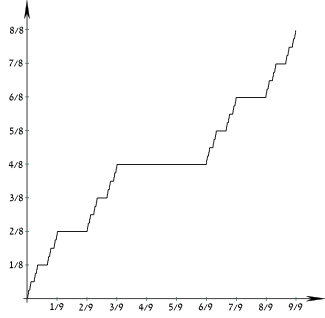Cantor distribution
This articleneeds additional citations forverification.(January 2017) |
|
Cumulative distribution function  | |||
| Parameters | none | ||
|---|---|---|---|
| Support | Cantor set,a subset of [0,1] | ||
| PMF | none | ||
| CDF | Cantor function | ||
| Mean | 1/2 | ||
| Median | anywhere in [1/3, 2/3] | ||
| Mode | n/a | ||
| Variance | 1/8 | ||
| Skewness | 0 | ||
| Excess kurtosis | −8/5 | ||
| MGF | |||
| CF | |||
TheCantor distributionis theprobability distributionwhosecumulative distribution functionis theCantor function.
This distribution has neither aprobability density functionnor aprobability mass function,since although its cumulative distribution function is acontinuous function,the distribution is notabsolutely continuouswith respect toLebesgue measure,nor does it have any point-masses. It is thus neither a discrete nor an absolutely continuous probability distribution, nor is it a mixture of these. Rather it is an example of asingular distribution.
Its cumulative distribution function is continuous everywhere but horizontal almost everywhere, so is sometimes referred to as theDevil's staircase,although that term has a more general meaning.
Characterization[edit]
Thesupportof the Cantor distribution is theCantor set,itself the intersection of the (countably infinitely many) sets:
The Cantor distribution is the unique probability distribution for which for anyCt(t∈ { 0, 1, 2, 3,... }), the probability of a particular interval inCtcontaining the Cantor-distributed random variable is identically 2−ton each one of the 2tintervals.
Moments[edit]
It is easy to see by symmetry and being bounded that for arandom variableXhaving this distribution, itsexpected valueE(X) = 1/2, and that all odd central moments ofXare 0.
Thelaw of total variancecan be used to find thevariancevar(X), as follows. For the above setC1,letY= 0 ifX∈ [0,1/3], and 1 ifX∈ [2/3,1]. Then:
From this we get:
A closed-form expression for any evencentral momentcan be found by first obtaining the evencumulants[1]
whereB2nis the 2nthBernoulli number,and thenexpressing the moments as functions of the cumulants.
References[edit]
- ^Morrison, Kent (1998-07-23)."Random Walks with Decreasing Steps"(PDF).Department of Mathematics, California Polytechnic State University. Archived fromthe original(PDF)on 2015-12-02.Retrieved2007-02-16.
Further reading[edit]
- Hewitt, E.; Stromberg, K. (1965).Real and Abstract Analysis.Berlin-Heidelberg-New York: Springer-Verlag.This, as with other standard texts, has the Cantor function and its one sided derivates.
- Hu, Tian-You; Lau, Ka Sing (2002). "Fourier Asymptotics of Cantor Type Measures at Infinity".Proc. AMS.Vol. 130, no. 9. pp. 2711–2717.This is more modern than the other texts in this reference list.
- Knill, O. (2006).Probability Theory & Stochastic Processes.India: Overseas Press.
- Mattilla, P. (1995).Geometry of Sets in Euclidean Spaces.San Francisco: Cambridge University Press.This has more advanced material on fractals.



![{\displaystyle {\begin{aligned}C_{0}={}&[0,1]\\[8pt]C_{1}={}&[0,1/3]\cup [2/3,1]\\[8pt]C_{2}={}&[0,1/9]\cup [2/9,1/3]\cup [2/3,7/9]\cup [8/9,1]\\[8pt]C_{3}={}&[0,1/27]\cup [2/27,1/9]\cup [2/9,7/27]\cup [8/27,1/3]\cup \\[4pt]{}&[2/3,19/27]\cup [20/27,7/9]\cup [8/9,25/27]\cup [26/27,1]\\[8pt]C_{4}={}&[0,1/81]\cup [2/81,1/27]\cup [2/27,7/81]\cup [8/81,1/9]\cup [2/9,19/81]\cup [20/81,7/27]\cup \\[4pt]&[8/27,25/81]\cup [26/81,1/3]\cup [2/3,55/81]\cup [56/81,19/27]\cup [20/27,61/81]\cup \\[4pt]&[62/81,21/27]\cup [8/9,73/81]\cup [74/81,25/27]\cup [26/27,79/81]\cup [80/81,1]\\[8pt]C_{5}={}&\cdots \end{aligned}}}](https://wikimedia.org/api/rest_v1/media/math/render/svg/066362d7de9b7a1d0bcf600d1dd5a2fcb9196ae4)


